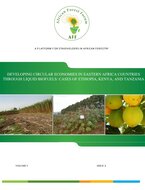The African Forest Forum (AFF) has undertaken studies in four African sub-regions to assess the potential of selected African countries to produce and use of liquid biofuels as a strategy for developing green and circular economies. The sub regions are eastern, southern, central and western Africa. This report is on three eastern Africa countries namely of Ethiopia, Kenya and Tanzania. Then the outputs of this study are expected to facilitate planning the growth and development of local and national liquid biofuel sector based on information and data obtained from field and factory visits, interviews and discussions with some national government and Non-Governmental Organizations (NGOs), and other stakeholders related to the liquid biofuel industry.
Liquid biofuels commonly available in eastern Africa are bioethanol and biodiesel produced from higher plants, though there was ongoing research on liquid biofuel from microalgae. In Ethiopia, land highly suitable for production of feedstock was estimated that 7.2 million ha (6.3%) for jatropha, 7.68 million ha (6.8%) for croton, 11.47 million ha (10.2%) for cassava, 40.91 million ha (36.2%) for sweet sorghum, and 0.7 million ha (0.62%) for sugarcane. In Kenya, 17.4 million ha (30.6%) land area was suitable for sweet sorghum, 6.39 million ha (11.2%) for cassava, 1.26 million ha (2.2%) for sugarcane, and 14.9 million ha (26.2%) for jatropha. In Tanzania, the suitable land area is 22.79million ha (22.9%) for cassava, 18.96million ha (21.5%) for sugarcane, 31.51million ha (35.8%) for sweet sorghum, and 17.78million ha (20.2%) for sunflower.
Investments in liquid biofuel production in the years 2010s were not profitable, resulting in investors abandoning investments on feedstocks like jatropha and related biodieselcrops. The only investment that remained was the already well-known sugarcane production mainly for sugar and molasses bioethanol. The use of sugarcane for the production of biofuels has been observed in13 sugar factories in Ethiopia, 16 sugar factories in Kenya, and five sugar factories in Tanzania. The reported annual production of ethanol was 24.25 million liters in Ethiopia, 8.25 million in Kenya and 1.4 million in Tanzania from one or two sugar factories. Improving productivity of sugarcane by increasing the yield to 138 tons or more per hectare, combined with improvement in technology by reducing wastage in molasses, and ethanol production, could enable the existing Ethiopian sugarcane factories to produce in full capacity at 432.41 million liters of ethanol per year, and those in the Kenyan at 289.28 million liters/year and the ones in Tanzanian at 81.64 million liters/year, when operating on an average of 250 working days/year. The production costs for conventional liquid biofuels are mainly the feedstock costs that account for 60-90% of the total production cost. This has given rise to the use of cheap sources such as lignocellulosic biomass waste, agricultural residues, and sugarcane bagasse. These were reported to vary annually from about 2.2 million tons of agricultural residues in Kenya, to 19.7 million tons in Ethiopia, in addition to 24.2 million tons of woody biomass residues in Kenya to 105.2 million tons in Ethiopia that could be used for lignocellulosic bioethanol production. From lignocellulosic biomass processing, the total bioethanol production could reach 8.2 billion liters/year in Kenya, 10.8 billion liters in Tanzania to 35.7 billion liters/year in Ethiopia, which is higher than their imports of petroleum.
Bio-oil (pyrolysis oil) is another liquid biofuel that can be obtained by burning biomass at 400 to 1000°C under limited oxygen environment. Pyrolysis oil producing biomass includes eucalyptus species, in addition to other biomass resources. Microalgae oil is identified as a potential biodiesel feedstock in Ethiopia, Kenya and Tanzania as these tropical countries have favorable climatic conditions. Microalgae are promising liquid biofuel feedstock due to its rapid growth rate and many times harvest, and without taking up land under food crops or forests. Microalgae can produce 11,238litres biodiesel per hectar per year, which is higher than the 150litres biodiesel from a hectare of jatropha and higher than the 700 liters of ethanol in a hectare of sugarcane. The use of ethanol for cooking at household level reduces emission that can be created by solid biomass fuel including 99.8% of particulate matter created by burning solid biomass in three stone stoves and 91.0% of that created by wood/charcoal Rocket Combo stoves. Improving the E15 in Ethiopia could have an abatement potential of 0.2 Mt CO2e in 2030. In Kenya, adoption of low carbon using biodiesel has an abatement potential of 1.2 MtCO2e. Tanzania has a commitment to reduce greenhouse gas emissions economy-wide between 138 – 153 MtCO2e by 2030 by promoting clean technologies.
The eastern Africa national governments ambitious plans to produce liquid biofuel had minimal achievements because of institutional, market, technical and legal challenges. Many of these can be overcome by providing comprehensive support for out growers, supporting seed production and diversifying feedstock, in addition to providing training and financial incentive, as well as researching different types of feedstocks that have high yield. There are also needs to improve water use efficiency in production and providing supportive/enabling policies. Also, the liquid biofuel investment in eastern Africa had adversely affected crop land in many places because it was not based on pre-assessment of land-use. Much as there was and continues to exist good potential domestic and foreign markets for liquid biofuel, the failure on the initial biofuel production investment resulted in idleness of land that was allocated to production of feedstock and supporting infrastructure, mistrust between local people who lost land and the investors, and loss of labor. That notwithstanding, given the new impetus on renewable energy, forestry and agricultural
professionals should aggressively continue researching on appropriate and productive bioenergy crops.

